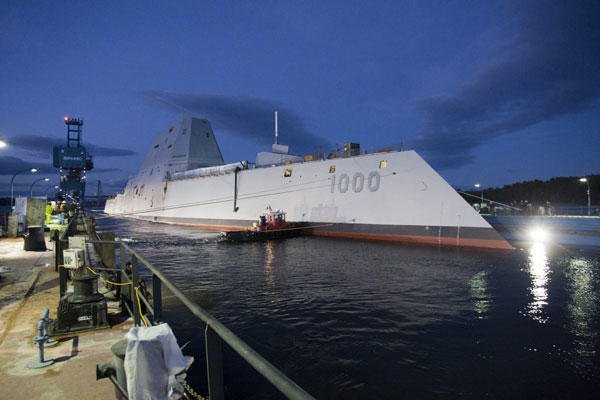The Navy's first high-tech Zumwalt-class DDG 1000 destroyer will pioneer a handful of yet-to-be seen destroyer technologies when it is christened this coming weekend.
Not only does the ship have a new electric drive system -- as opposed to diesel or steam -- for propulsion, the ship is configured with sonar, sensors, and weapons systems that have not previously been engineered into a Navy destroyer, said Raytheon's Wade Knudson, DDG 1000 program manager.
The Zumwalt-class destroyers will have unprecedented mine-detecting sonar technologies for destroyers using an integrated undersea warfare system. This system is a dual-band sonar technology which uses both medium and high-frequency detection, Knudson said.
Medium sonar frequency is engineered to detect ships and submarines, whereas high-frequency sonar adds the ability to avoid sea-mines, he added.
It makes sense that the DDG 1000 would be engineered to detect mines because the destroyer is, in part, being developed for land-attack missions -- an activity likely to bring the vessel closer to shore than previous destroyers might go.
The DDG 1000 is built with software and blade servers to manage the weapons systems on the ship and handle the radar and fire control software along with various logistical items such as water, fuel, oil and power for the ship, Knudson explained.
"The blade servers run seven million lines of code," he said.
The ship is engineered to fire Tomahawk missiles, the Evolved Sea Sparrow Missile and a range of standard missiles such as the SM2, SM3 and SM6, Knudson said.
The ship also has a 155mm long range, precision-capable gun called the Advanced Gun System made by BAE Systems. The weapon can, among other things, fire a munition called the Long-Range Land Attack Projectile, which can strike target at ranges out to 64 nautical miles.
Many of the blade servers and other technical items are housed in structures called electronic modular enclosures, or EMEs. There are 16 EME's built on each ship, each with more than 235 electronics cabinets. The structures are designed to safeguard much of the core electronics for the ship.
The ship's integrated power system, which includes its electric propulsion, helps generate up to 58 megawatts of on-board electrical power, something seen as key to the future when it comes to ship technologies and the application of anticipated future weapons systems such as laser weapons and rail guns.
The ship is also built with a new kind of vertical launch tubes that are engineered into the hull near the perimeter of the ship. Called the Peripheral Vertical Launch System, the tubes are integrated with the hull around the ship's periphery in order to ensure that weapons can keep firing should the ship be damaged. Instead of having all of the launch tubes in succession or near one another, the DDG 1000 has spread them out in order to mitigate risk in the event attack, Knudson said.
"This divides the weapons up so if you take a hit, you don't lose all your weapons. This is a survivability enhancement," he added.
In total, there are 80 launch tubes built into the hull of the DDG 1000, Knudson said. The Peripheral Vertical Launch System involves a collaborative effort between Raytheon and BAE Systems.
The DDG 1000 also has an AN/SPY-3 X-band multi-function radar which is described as volume-search capable, meaning it can detect threats at higher volumes than other comparable radar systems, Knudson explained. The volume search capability, which can be added through software upgrades, enables the radar to detect a wider range of missile flight profiles, he added.
As the first Zumwalt-class destroyer gets ready to be christened, construction of the second is already underway. The DDG 1001 is already 75-percent complete and fabrication of DDG 1002 is slated to begin this month, Navy officials said.
-- Kris Osborn can be reached at kris.osborn@monster.com






























